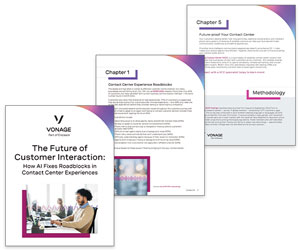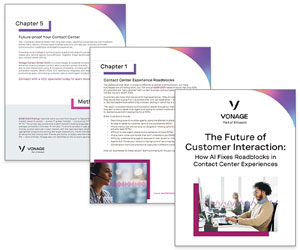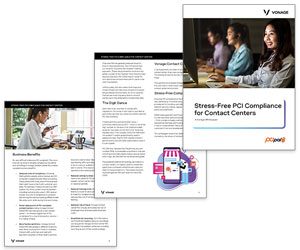Contact centre automation presents a powerful solution. Businesses can wave goodbye to repetitive manual processes while boosting speed and efficiency.
At the same time, agents become free to focus on the tasks that matter most. Wondering how to get started? In this guide, Vonage looks at what it is, top trends, and how to figure out what works for you.
What is Contact Centre Automation?
Running a contact centre involves many different essential but repetitive activities.
Contact centre automation is designed to cut the time spent on these manual tasks. By combining various technologies, such as robotic process automation (RPA) and natural language processing (NLP), contact centre automation solutions can handle everything from call routing to post-call data entry.
This results in happier customers, fewer costs, and boosted efficiency.
What are the Benefits of Contact Centre Automation?
As we’ve mentioned, contact centre automation brings many advantages. Let’s give a rundown of some of the top examples.
Better Customer Experiences
Put yourself in the shoes of the average caller for a moment. When you contact customer support, you expect swift results. Anything less than this will quickly become frustrating.
Automation helps your team deliver better experiences in various ways. First, by reducing manual tasks, you free up more agents. More staff will be available to respond to callers, reducing wait time.
Plus, using tools like virtual agents, you can resolve simple queries without having to wait for an agent at all. If all a customer wants to do is check their order status, they can get an answer immediately, keeping them happy and leaving your agents free to handle more complex issues.
Automation can also provide a smoother experience for both customers and agents. Instead of agents manually searching for customer information, automation can have it up on their screen as soon as contact is made.
Customers don’t have to repeat themselves, and agents can provide a personalized experience for everyone.
Reduce Operational Costs
Running a contact centre can be expensive, whether it’s the cost of labour, hardware, or infrastructure. Left unmanaged, these costs can easily burn a hole in a business’s wallet.
Automation allows a business to operate with a smaller team while maintaining quality. With a much-reduced list of manual tasks, you’ll need to employ a less-extensive team and provide fewer resources.
Combine this with solutions that operate in the cloud, and you can dramatically reduce the amount of onsite infrastructure required.
Predictive planning can also help optimize staff usage, ensuring sufficient agents are always available for peak times while avoiding overstaffing at other times.
Boost Staff Retention
Employees often find manual tasks to be repetitive and boring. They’d rather work on activities that have a meaningful impact on your organization. Too much focus on manual tasks can lead to staff seeking employment elsewhere.
Automation frees your team to spend time on more interesting tasks. It also makes their lives easier by providing intelligent assistance during calls. As a result, employees feel contented and engaged and are less likely to leave their roles.
Fewer Mistakes
Even the most seasoned team members occasionally slip up. And, as any organization knows, even the smallest errors can be costly.
Contact centre automation tools are programmed to carry out tasks “to the letter.” They will never tire or lose interest in repetitive activities. As long as a tool has been given the correct instructions, and these are reviewed regularly, there’s no risk of mistakes.
How Does Contact Centre Automation Work?
Modern automation tools are powered by artificial intelligence. More specifically, they use a subset of AI called machine learning (ML).
This involves algorithms that are trained on large datasets and generalize from there to new data, providing useful insights and being able to perform tasks without manual intervention.
One major advantage of ML automation is that it requires little human oversight. Once a tool has been programmed, it will begin work and carry out its task until it is told to stop. Regular reviews are needed to ensure no deviation or bias is creeping in.
Thanks to ML, contact centre technology can find newer, more intelligent ways of automating processes. By combining data from across your contact centre, a tool can spot bottlenecks and boost efficiency.
Due to its diverse capabilities, ML automation can also be used for many purposes. Use cases include conversational AI, call monitoring and reporting, agent assist, and many others. We’ll discuss these in more detail shortly.
What Are the Challenges of Implementing Contact Centre Automation?
Contact centre AI automation can introduce new challenges, as with any new technology. When implementing your solution, consider the following hurdles.
Agent Resistance
Your agents will be accustomed to working a certain way. It’s not unusual for some to feel unsure about automation. Take the time to dissuade these fears.
Explain the benefits of automation and how it will assist agents. Above all, highlight that it will enhance rather than replace your team.
Negative Customer Perceptions
Some customers may have negative perceptions toward AI. They may worry that their queries are not getting the attention they deserve or that interactions lack a “human touch.”
To avoid this situation, use an intelligent solution that can replicate natural conversations and always be upfront about when a customer is talking to a virtual agent rather than a staff member. Ensure human agents remain central to your approach and can be reached if required.
Training and education, While automation carries out tasks for you, it’s still important that agents know how to work alongside AI. You’ll need to put aside some time and resources to educate your team.
Contact Centre Automation Examples
As mentioned, call centre automation is an extremely diverse tool. Let’s explore some of the top AI contact centre automation use cases.
AI Chatbots
Conversational AI-powered chatbots, known as virtual agents, are one of the biggest developments in machine learning. This technology can respond to user prompts.
Customers can send various queries to a virtual agent and receive intelligent answers. What’s more, the agent can learn from each interaction and provide better solutions in the future.
This form of AI can be used on many different platforms and channels. While call centres will have their virtual assistants manning the phones, contact centres can use them over email and social media.
AI can handle basic to medium queries, while human agents tackle more complex issues. This method also helps to reduce queuing, as customers can access a virtual agent instantly.
Interactive Voice Response (IVR)
Interactive voice response (IVR) guides a caller through different menus. IVR uses a technology called natural language processing.
This analyses human speech and generates relevant responses. The idea is that callers can be quickly directed to the information they need.
When a caller asks a question, the system searches a database of preprogrammed responses. If it’s unable to gather the information that a caller needs, it introduces a human agent. As with virtual assistants, this reduces queuing so that callers with urgent issues can see a human agent more quickly.
Intelligent Call Routing
When customers contact your call centre, they want quick answers. Above all, they expect to be directed to the professional best suited to answer their query.
Intelligent call routing is one of the most effective forms of automation contact centre solutions can provide. AI will analyse call data and find the best route to solve a customer’s query. Contact centre automation can use various routing logic during this process. This includes:
- Routing to an agent with the best skills to handle their query
- Sending calls that have been assigned a high priority to agents first
- Routing to an agent that is geographically closest to a caller
- Giving users an option to receive a return call to avoid queuing
Contact Centre Performance Monitoring
The best contact centres adapt and learn from successes and failures. However, contact centres need ways to collect and analyse data to track performance.
Automation tools can handle this process for you. They provide easy access to reports on agent performance, customer satisfaction, and other key areas.
What’s more, they centralize all this information within a comprehensive dashboard. From there, you can assign key metrics, visualizations, and other information to aid decision-making.
Contact Centre Automation Trends For 2025
Contact centres have experienced massive technological development in recent years, and this trend is set to continue. Here are some of the top automation trends to look for this year.
Increased Use of AI-Powered Personal Assistants
AI personal assistants greatly boost call centre efficiency. These tools can handle tasks such as data entry, call scheduling, and other repetitive tasks.
Hyper Personalization
Hyper-personalization combines real-time data with predictive analytics and machine learning. This will enable communications that are completely tailored to customer needs.
Omnichannel Automation
Customers want consistent experiences across all channels, and omnichannel automation ensures seamless interactions.
For example, a customer might begin a query on their mobile device via text chat. They then call your contact centre.
Omnichannel automation ensures they can continue where they left off, providing agents with all the relevant information.
Increased Use of Sentiment Analysis
What if there was an easy to find out what customers think of you? Sentiment analysis analyses customer speech to inform whether they are “positive,” “negative,” or “neutral.” Agents can use this to monitor customer interactions and alter their approach when needed.
How to Determine What Automation to Use in a Contact Centre
With so many different forms of automation, it can be difficult to know where to start. Be sure to bear the following points in mind when planning your automation.
Assess Your Needs
Begin by assessing your contact centre’s performance. Create a comprehensive list of its strengths and weaknesses. Next to each weakness, list ways automation might help.
Involve all relevant stakeholders in this process. By getting early buy-in, you’re more likely to deliver automation that meets everyone’s needs.
Consider Your Budget
It probably isn’t realistic to automate everything at once. Small contact centre automation must be carried out within the constraints of a budget.
A gradual approach may be more financially viable and help the team transition to the new technology. Prioritize and focus on areas that will benefit most from automation.
Outline Automation Goals
Once you’ve decided how contact centre automation will play a role, setting goals is important. These will help you gauge the success of your automation strategy and decide whether new tactics are necessary. Monitor the results carefully and adjust your approach where needed.
Always opt for measurable goals that align with relevant metrics. Some examples include:
- Customer satisfaction (CSAT) – Measures whether customers are content with contact centre interactions. Ultimately, automation should produce happier customers.
- Agent effort score – Tracks whether agents can support customers easily. Automation should make agents’ lives easier.
- Call abandonment rate – Shows the percentage of customers who leave before connecting to an agent. Automated tools such as IVR should reduce queuing and lower the abandonment rate.
Best Practices For Automating Your Contact Centre
There’s no denying that automation can be transformative for your contact centre. But how can you ensure a smooth implementation?
Adhering to the following best practices can help you succeed when introducing your contact centre automation solution.
Prepare Your Team
As we’ve established, some members of your team might be unsure about automation. The easiest way to allay fears is through preparation and education.
Upload resources to your learning management system and provide targeted training as needed. Let team members test out tools before their introduction so they understand how they work.
Create Seamless Experiences
It can be jarring if customers feel like they are talking to a robot. To avoid this, make sure it’s clear when a customer is talking to a virtual agent and that human agents can jump into customer interactions whenever necessary.
Personalize Where Possible
As we’ve discussed, modern customers love personalization. Consider how you can integrate data to automate more tailored experiences.
This might be through routing – ensuring a caller reaches someone who speaks their language, for instance – or simply by ensuring the agent has all relevant information to hand during communications.
Always Adapt
We’re in a period of constant change. To stay relevant, keep up to date with the latest automation developments. Focus on adapting and introducing new technologies, especially those that improve customer experiences.
Monitor and adjust
As mentioned, choosing the right metrics for your automation goals is key to success. Monitor these regularly to see whether your strategy is headed in the right direction. Make adjustments where appropriate to stay on track.
Increase Efficiency and Productivity With Contact Centre Automation
Decided that contact centre automation is just what you need? Vonage offers it through its cloud-based solutions and AI-powered tools. Vonage includes features such as:
- AI-driven virtual assistants allow you to automate routine tasks like answering FAQs or guiding customers to the right agent.
- Smart call routing directs calls to the most appropriate agent based on customer needs or history.
- Workflow automation helps streamline processes such as ticket creation, follow-ups, and notifications to save time and reduce errors.
- Real-time analytics provide actionable insights to optimize agent performance and improve decision-making.
These automation features help businesses enhance efficiency, reduce wait times, and deliver seamless customer experiences, making Vonage a strong choice for modern contact centres.
This blog post has been re-published by kind permission of Vonage – View the Original Article
For more information about Vonage - visit the Vonage Website
Call Centre Helper is not responsible for the content of these guest blog posts. The opinions expressed in this article are those of the author, and do not necessarily reflect those of Call Centre Helper.
Author: Vonage
Reviewed by: Rachael Trickey
Published On: 1st Jul 2025
Read more about - Guest Blogs, Vonage






 Vonage is redefining business communications, helping enterprises use fully-integrated unified communications, contact centre and programmable communications solutions via APIs.
Vonage is redefining business communications, helping enterprises use fully-integrated unified communications, contact centre and programmable communications solutions via APIs. 


































